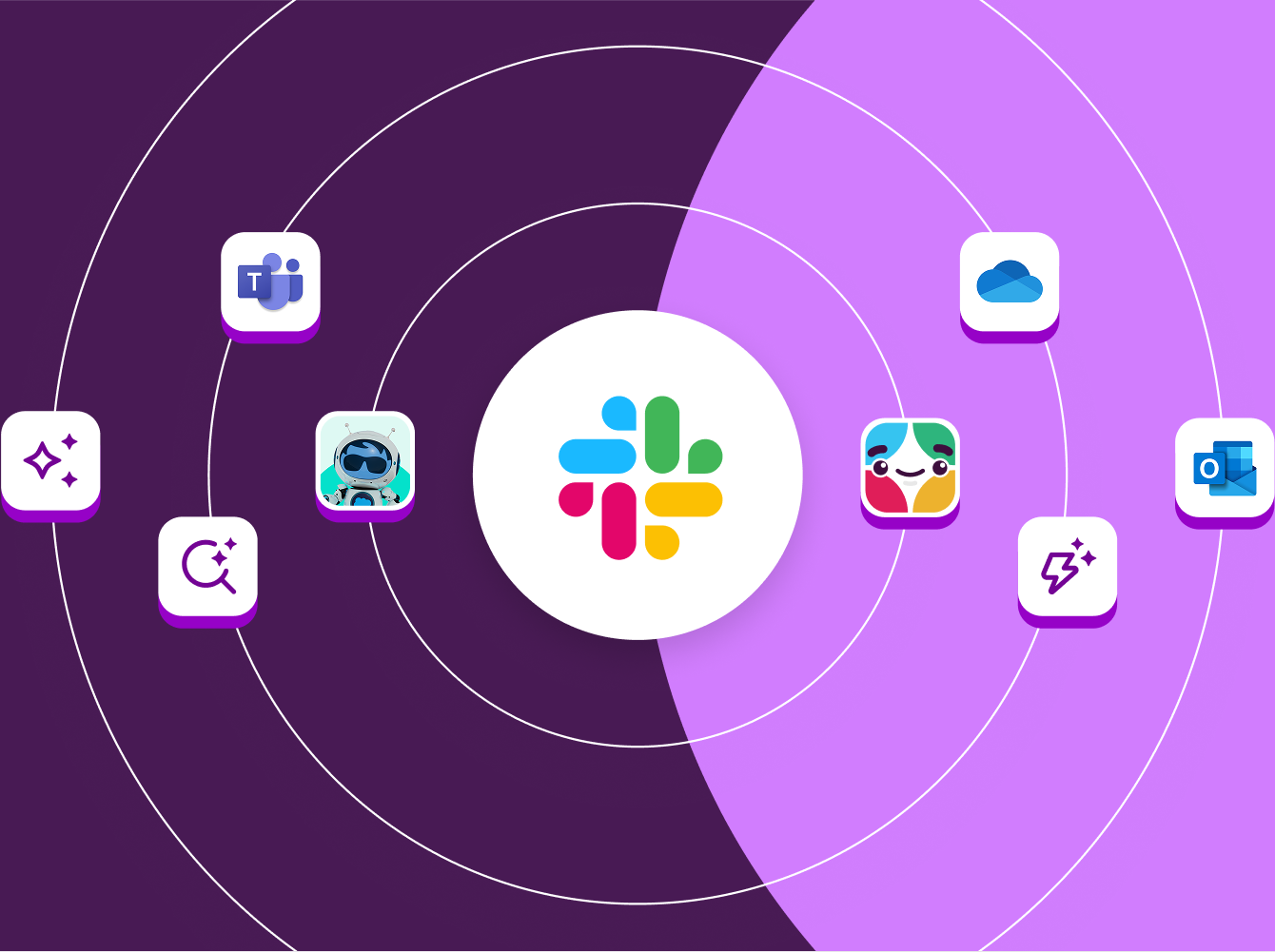El Departamento de Recursos Humanos (RR. HH.) es la base de la experiencia del empleado. Estos equipos están recurriendo a Slack para colaborar con los distintos departamentos, compartir recursos y garantizar la implicación de los empleados, todo desde un mismo lugar, a fin de tener un impacto real en el proceso de selección, contratación y permanencia de los empleados.
24 %
de aumento de la rapidez para conseguir la plena productividad de los empleados gracias al uso de Slack
5,9 %
de aumento de la satisfacción de los empleados al utilizar Slack
89 %
de los usuarios coinciden en que Slack les ha ayudado a estar más conectados como equipo
Comunicación más clara
Aprende a utilizar Slack para comunicarte internamente de forma eficaz.
Canales
En la actualidad, los responsables de selección de personal y sus equipos demandan un enfoque moderno y sencillo para la comunicación laboral, por lo que las herramientas de colaboración tradicionales, como el correo electrónico y las llamadas en conferencia, ya no son suficientes. En cambio, los canales de Slack permiten comunicarse en tiempo real y mantener a los empleados, responsables y otras partes interesadas informados en todo momento.
Ejemplos de canales:
- Canal #equipo-rrhh que ofrezca al equipo un espacio reservado para debatir estrategias de contratación, coordinar programas de formación y garantizar el cumplimiento de las leyes y normativas pertinentes.
- Canales cerrados de #contratación-[puesto] para cada persona entrevistada, en los que los responsables y gestores del talento puedan centralizar todo el proceso de contratación. Todos los panelistas y partes interesadas tendrán acceso a las notas de la entrevista, los comentarios y los currículos, además de poder realizar comunicaciones cuando un entrevistador no pueda asistir.
- Canal de #presentaciones o #bienvenida para toda la empresa que permita presentar a los nuevos empleados y ayudarles a estrechar lazos más rápidamente. Puedes crear canales de #bienvenida más pequeños para equipos como satisfacción del cliente, ventas o marketing, entre otros. Además, en este canal se pueden compartir datos curiosos como, por ejemplo, si el nuevo empleado tiene tres gatos siameses o si es submarinista.
- Canales cerrados de#remuneración para ofrecer a los responsables un lugar en el que debatir y aprobar la remuneración de los empleados actuales y futuros. Asegúrate de crear uno por persona, por ejemplo #oferta-pedro-márquez-gerente-satisfacción-cliente o #ascenso-pedro-márquez-gerente-satisfacción-cliente.
- Canal #anuncios-rrhh para mantener a todo el mundo informado de las fechas de vencimiento de la inscripción abierta, las tareas de evaluación del rendimiento y los cambios en la política de toda la empresa.
Canales #padres-y-madres, #lgbtq y otros grupos de recursos para empleados (ERG) para ofrecer a personas de distintas procedencias un lugar donde encontrar apoyo y relacionarse. Anima a los empleados a unirse o a crear nuevos ERG con los que se identifiquen para tener una cultura inclusiva. - #mascotas, #deportes y otros canales para ofrecer a los empleados un espacio divertido donde compartir sus aficiones e intereses.
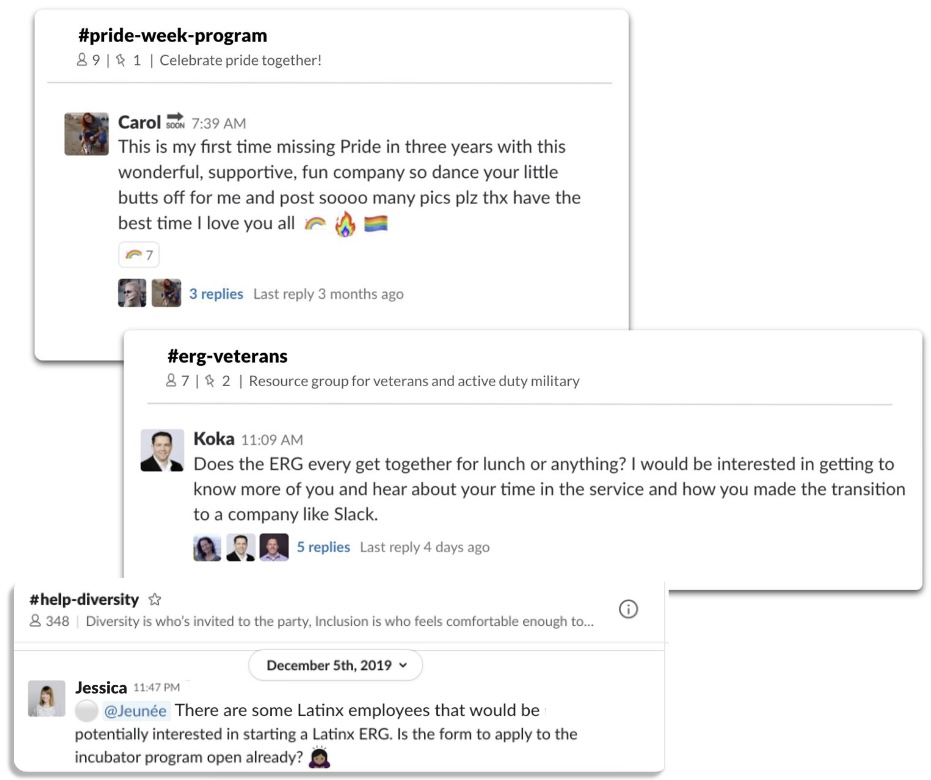
Marca como favoritos los canales que utilices con más frecuencia para que aparezcan en la parte superior de la barra lateral y te resulte más fácil encontrarlos. Para mantener la barra lateral organizada, crea secciones y agrupa canales similares. Por ejemplo, crea una sección para necesidades de contratación, ascensos, mensajes directos, canales de equipo y proyectos.
Obtén más información sobre cómo crear un canal.
Canales cerrados vs. abiertos
Los canales cerrados no están disponibles para todos los miembros, por lo que permiten proteger la información y las comunicaciones confidenciales. En un canal cerrado, solo los miembros del canal pueden añadir a otras personas y acceder a los mensajes o archivos publicados. Puedes utilizarlos para:
- Conversaciones sobre contratación
- Revisiones salariales
- Revisiones de ascensos
- ERG (solo miembros)
Los canales abiertos están a disposición de todos los miembros y son una excelente forma de fomentar la transparencia y la inclusión. Cualquier miembro de tu espacio de trabajo puede ver y unirse a los canales abiertos, así como buscar todos los mensajes y archivos compartidos en ellos. Utiliza los canales abiertos para:
- Presentaciones de nuevos empleados
- Anuncios generales de RR. HH.
- Canales sociales
- Apoyo a ERG
Cuando crees un canal, podrás decidir si es abierto o cerrado. Si fuera necesario, puedes convertir el canal en cualquier momento. Para mantener ordenado el espacio de trabajo de Slack, tienes la opción de archivar un canal una vez finalizado un proyecto o una fase de contratación. Podrás seguir consultando el contenido del canal y convertirlo a solo lectura. Todo el mundo puede consultar los canales abiertos archivados, pero que solo los miembros pueden consultar los canales cerrados archivados.
Perfiles de Slack
En un entorno de trabajo remoto e híbrido, el contexto lo es todo, sobre todo al trabajar con nuevos compañeros de la organización. Hasta los empleados más veteranos pueden llegar a preguntarse durante grandes reuniones virtuales, ¿quién es ese? Ayuda a los empleados a comunicarse y colaborar rápidamente con las personas adecuadas en el contexto adecuado con los perfiles detallados de Slack.
Con la ayuda de un administrador, añade campos de perfil para todos los miembros de tu organización. Aquí tienes algunos ejemplos de campos que puedes añadir:
- Información de contacto: añade varias direcciones de correo electrónico y números de teléfono para que los compañeros de equipo sepan cómo pueden ponerse en contacto.
- Pronunciación del nombre: pronunciar correctamente el nombre de un compañero de equipo le hace sentirse respetado y valorado. Los usuarios pueden grabar cómo se pronuncia su nombre o añadir la grafía fonética.
- Pronombres: fomenta una cultura inclusiva animando a todo el mundo a añadir sus pronombres. Al pasar el cursor sobre el perfil de Slack de alguien, se mostrarán sus pronombres.
- Hora local y ubicación: recomienda a los empleados que añadan su hora local y su ubicación (incluida la remota, híbrida o en la oficina) para que los compañeros sepan en qué zona horaria y en qué entorno trabaja cada uno. También pueden marcar la casilla de establecer la zona horaria automáticamente para que la zona horaria se actualice si van de viaje. Consejo profesional: actualiza tu estado de Slack a “🏢 en la oficina” para que puedas conocer a tus compañeros en persona.
- Organigrama: si tienes un plan Enterprise Grid o Business+ con el complemento Atlas de Slack, puedes crear un organigrama para que los empleados sepan fácilmente cuál es la jerarquía de subordinación de tu organización. Los organigramas se rellenan automáticamente actualizando el campo managerId mediante la SCIM o la API web.
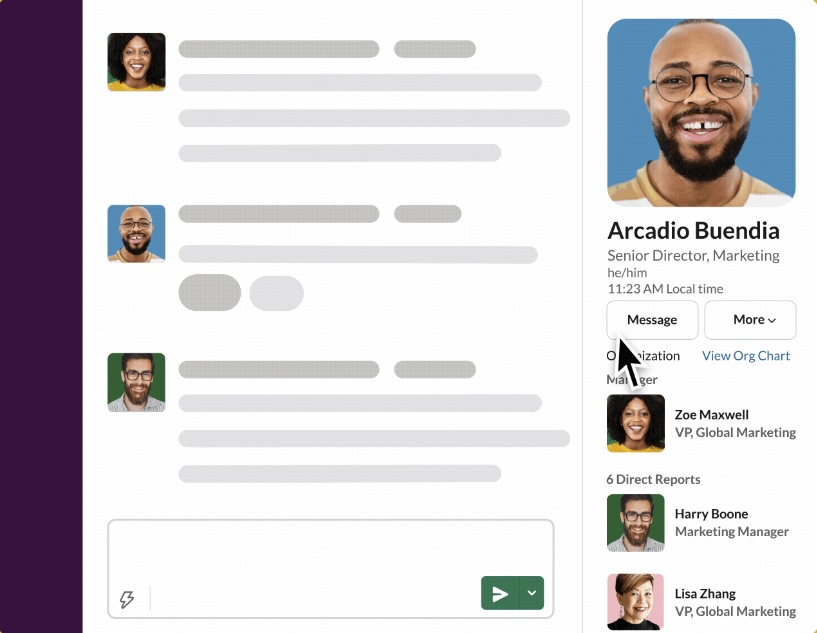
Obtén más información sobre cómo ampliar la funcionalidad de los perfiles de tu organización con Atlas de Slack.
Optimización de los procesos, desde la contratación hasta la incorporación de los empleados
Integración del sistema de seguimiento de solicitudes
No solo los candidatos deben intentar causar una buena primera impresión, sino que tú también debes hacerlo. La competencia por captar a los mejores candidatos es más intensa que nunca, por lo que contar con un proceso de contratación eficiente, rápido y moderno puede marcar la diferencia.
Al integrar tu sistema de seguimiento de solicitudes, perderás menos tiempo cambiando entre aplicaciones para ordenador nativas o pestañas del navegador y podrás centrarte en avanzar en el proceso de contratación para fichar a la persona adecuada. Con estas integraciones podrá mantener informados a los candidatos y a las partes interesadas en todas las fases de la selección de personal:
- Greenhouse: envía notificaciones de contratación directamente a un usuario o a un canal específico de Slack, incluyendo aprobaciones, nuevos candidatos, nuevas recomendaciones, envíos de agencias y fechas de vencimiento de fichas de evaluación. Incluso puedes aprobar o rechazar ofertas de trabajo directamente en Slack.
- Lever: implica a todo tu equipo en el proceso de contratación enviando notificaciones detalladas desde la aplicación Lever a Slack. Comparte una nueva solicitud prometedora, recuerda a los entrevistadores que dejen sus comentarios, cambia los planes que tenías para un candidato in situ y mucho más.
- Recruitee: entérate de lo que está pasando en cada etapa con notificaciones sobre tus candidatos, procesos de contratación y actividades del equipo de selección. Recibe notificaciones cuando una parte interesada cambie a un candidato de etapa o deje comentarios o valoraciones.

Consulta la lista completa de integraciones de contratación.
Publicación de ofertas de empleos
Publicar un puesto de trabajo requiere mucho esfuerzo. Se precisa la opinión de varias partes interesadas. Puedes agilizar la búsqueda de nuevos talentos creando un canal cerrado para el puesto que necesites cubrir, por ejemplo, #contratación-director-marketing. Añade al canal a directores de contratación, responsables de departamento y reclutadores para que todos puedan hablar sobre el alcance, la franja salarial, el cargo y las responsabilidades del puesto. Una vez definida la descripción del puesto en colaboración con el equipo, publícala en el canal y fíjala para poder consultarla más tarde.
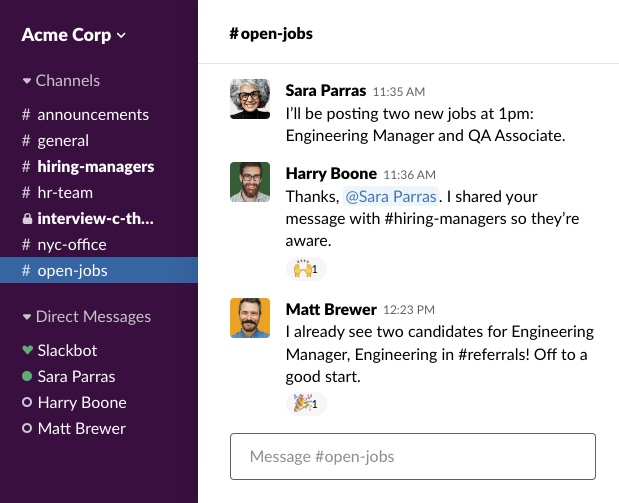
Una vez publicado el puesto en Internet, acuerda con el equipo un calendario para la primera ronda de entrevistas. Utiliza un canvas, un espacio en el que puedas crear y compartir contenido detallado, para mantener a todo el mundo coordinado. Crea una lista de verificación o un calendario con los hitos importantes que hay que alcanzar durante el proceso de contratación. Los interesados pueden revisar la información en cualquier momento pasando el ratón por encima del botón del canvas situado en la esquina superior derecha del canal.
Revisión de candidatos
Cuando empiecen a llegar las candidaturas, recopila los comentarios iniciales de las partes interesadas en el canal cerrado #contratación-puesto. Integra la aplicación Greenhouse para recibir alertas directamente en el canal cuando se presenten nuevos candidatos para que no se te escape ningún candidato válido.
Las partes interesadas pueden debatir sobre los candidatos entre sí y llegar más rápidamente a una decisión sobre la lista de preseleccionados para la entrevista. A continuación, utiliza hilos de conversación para crear debates organizados en torno a cada candidato preseleccionado. Con los hilos, puedes hacer un mejor seguimiento de los comentarios a medida que avanza el proceso de selección y facilitar la búsqueda de las opiniones sobre cada candidato.
Coordinación de entrevistas y opiniones de las partes interesadas
Programar una entrevista no es tarea fácil, dadas las apretadas agendas de las distintas partes interesadas. Utiliza tu canal para coordinar la entrevista más fácilmente. Envía un mensaje con una lista de posibles horarios y pide a todos que respondan con un rápido emoji con código de colores para ver qué franja horaria viene mejor.
Una vez confirmada la entrevista, envía un recordatorio a todos los interesados. Consejo profesional: fija la hora del recordatorio el día anterior o 30 minutos antes de la entrevista.
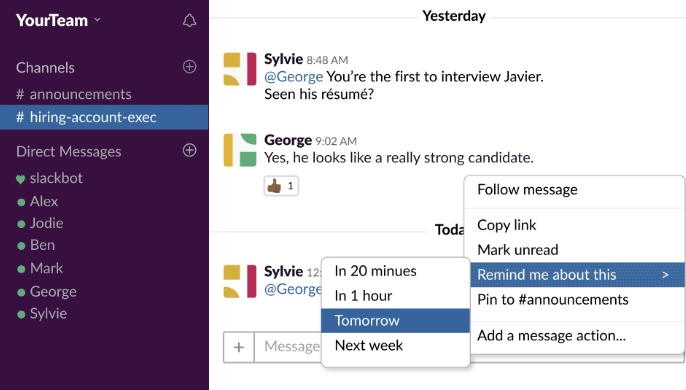
Cuando llegue el momento, Slackbot avisará a todos los miembros del canal, lo que les dará tiempo para revisar la solicitud del candidato y demás información antes de la entrevista.
También puedes utilizar aplicaciones especializadas de contratación, como Lever, para notificar a las partes interesadas de una próxima entrevista con una tarjeta de resumen directamente en Slack. Más tarde, Lever puede pedir a los entrevistadores que envíen sus comentarios, tanto una puntuación rápida para el candidato como comentarios escritos más detallados.
Organización de los documentos
Durante el proceso de selección, hay que controlar un montón de documentos, desde los currículos hasta las cartas de motivación, pasando por las hojas de evaluación. Mantén el orden fijando los documentos más importantes en la parte superior de los canales de contratación para poder encontrarlos en cualquier momento.
También puedes utilizar un canvas para crear un centro personalizado de información sobre los candidatos. Añade el nombre de cada candidato y adjunta sus currículos, hojas de evaluación y demás documentos importantes en un solo lugar. Incluso puedes organizar un canvas en columnas para estructurar de forma clara el calendario de contratación y otra información sobre los candidatos.
Incorporación
Una vez se ha firmado el contrato, llega el momento del primer día de los nuevos empleados. Consigue que se impliquen, se pongan al día y se sientan miembros valiosos del equipo desde el minuto uno.
- Dales la bienvenida en un canal de #presentaciones o #canal-general. Presenta a los candidatos seleccionados en un canal destinado a toda la empresa o a un equipo específico para ayudarles a sentirse como en casa y conseguir que interactúen con otros miembros del equipo.
- Crea un canal único para cada grupo de nuevos empleados. Crea canales exclusivos para cada grupo de nuevos empleados (por ejemplo, #nuevos-empleados-25sept) para formar minicomunidades privadas de apoyo mutuo. No te olvides de fijar en estos canales las preguntas más frecuentes, los documentos importantes y la información más relevante para que los nuevos empleados puedan encontrar respuestas a sus preguntas rápidamente.
- Invítalos a canales relevantes. Añade a los recién contratados a canales como proyectos, cuentas de clientes o departamentos en los que puedan trabajar en el futuro. Así, podrán revisar las publicaciones, los archivos, los miembros del equipo y las conversaciones fijadas desplazándose o buscando a su propio ritmo.
- Programa mensajes automáticos. Utiliza GreetBot para programar mensajes automáticos que mantengan a los nuevos empleados al día. Envía mensajes automáticos para compartir direcciones, programar reuniones de control, y recordar que hay que completar las solicitudes de prestaciones, así como para fomentar el contacto con los compañeros.
- Utiliza una plantilla de incorporación de nuevos empleados para disponer de un canal listo para usar que incluya toda la información importante para incorporar a tus nuevos empleados. Esta plantilla incluye una guía de incorporación, una lista de verificación de la primera semana y un asistente de incorporación en un lugar al que se puede acceder fácilmente. Solo tendrás que añadir algunos detalles.
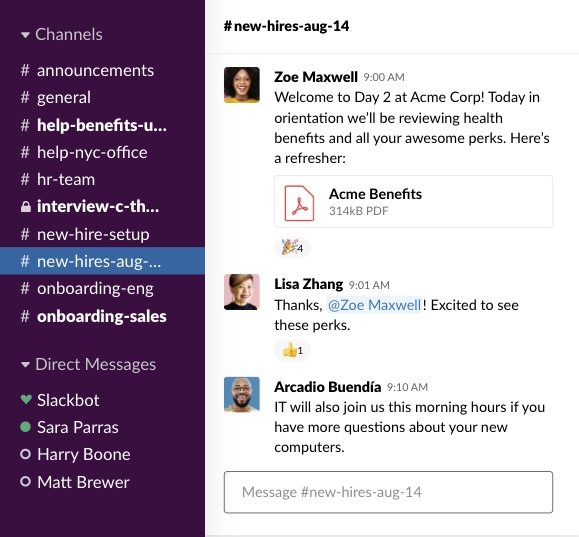
Ayuda a los empleados con el autoservicio de RR. HH.
Cómo utilizar Slack para automatizar y agilizar la asistencia a los empleados
Canales de información y ayuda de RR. HH.
Los canales como #anuncios-rrhh o #ayuda-rrhh mantienen a todo el mundo informado de las políticas y actualizaciones importantes. Asegúrate de fijar o añadir documentos o información importante al canvas del canal, incluido lo siguiente:
- Manual del empleado
- Cobertura general del plan de seguro médico, dental y de vida
- Plan de jubilación 401(k)
- Directrices y plazos para la inscripción abierta
- Directrices y plazos para la revisión de la remuneración y el rendimiento
Si los empleados no encuentran la respuesta a su pregunta en los recursos fijados, anímales a utilizar la función de búsqueda de Slack. Asegúrate de añadir preguntas frecuentes en modo de solo lectura en el canvas del canal para que los empleados puedan consultarlas rápidamente. Y si, aún así, necesitan más ayuda, proporciónales la posibilidad de ponerse en contacto contigo para solicitarla. Una vez completado el formulario, copia el enlace y fíjalo en la parte superior del canal para que los empleados puedan encontrarlo fácilmente.
Utilizar una plantilla de guía de beneficios para empleados puede ayudarte a agilizar el trabajo, al contar con un canvas en el que solo tienes que introducir información en áreas predefinidas, lo que te evita la tarea de organizar la información.
Automatización de las solicitudes de vacaciones remuneradas, las aprobaciones, el acceso a la nómina y mucho más
Incorpora tus herramientas de RR. HH. directamente a Slack para que los empleados puedan ocuparse de las tareas administrativas personales esenciales sin que tú tengas que hacer un gran esfuerzo. Integra ADP Virtual Assistant para ayudar a los empleados a:
- Crear solicitudes de días libres
- Ver su última nómina
- Comprobar la disponibilidad actual de días libres
- Consultar el saldo de su cuenta de jubilación
- Ver las inscripciones de beneficios activas
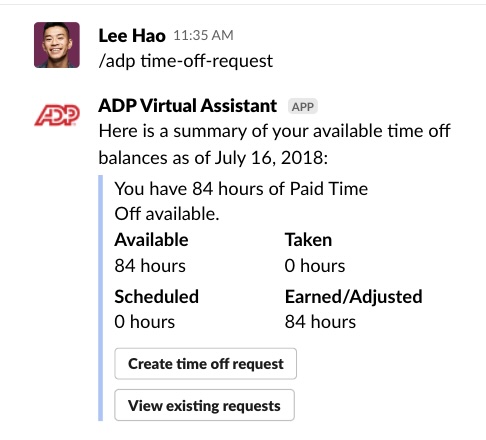
Una vez que apruebes las solicitudes de vacaciones remuneradas, los empleados recibirán automáticamente una notificación. También existen otras integraciones que pueden satisfacer las necesidades específicas de tu empresa. Te recomendamos estas herramientas clave de RR. HH.:
- Workday: accede a 75 acciones rápidas para realizar tareas clave con un panel personalizado en Slack. Envía solicitudes de días libres, comprueba la disponibilidad de vacaciones remuneradas, envía comentarios de compañeros, busca compañeros de trabajo y mucho más.
- AttendanceBot: permite a los empleados avisar de bajas por enfermedad, solicitar días libres, fichar la entrada y la salida de la jornada, crear calendarios de vacaciones y ver quién está de baja ese día, todo ello sin salir de Slack.
- BambooHR: utiliza las funciones más populares de BambooHR directamente en Slack, como la consulta de la disponibilidad de días libres, las solicitudes de días libres, un directorio de empleados y la consulta de quién está fuera de la oficina.
Aumento de la implicación de los empleados
Cómo utilizar Slack para mantener a los empleados motivados y entregados al máximo con el trabajo diario
Horario de oficina abierta
En un entorno de trabajo híbrido o remoto, es difícil reproducir las interacciones aleatorias que se producen cuando alguien pasa por tu mesa o vas a la cafetería. Con Slack, sin embargo, puedes facilitar esos encuentros sociales de forma virtual. Crea un horario de oficina abierta para que cualquiera pueda entrar en un canal y obtener ayuda, conocer a los nuevos empleados o simplemente charlar sobre sus planes para el fin de semana. Anima a todos los directores y responsables de equipo a que organicen horas de oficina abierta a la misma hora todas las semanas o una vez al mes mediante las juntas, conversaciones de vídeo o audio que tienen lugar en Slack.
Una vez iniciada la junta, cualquiera puede unirse al canal. También puedes activar los subtítulos en directo y elegir un tema para la junta.
Las charlas improvisadas también pueden tener lugar en una oficina digital mediante la integración de la aplicación Donut. Donut empareja automáticamente a los compañeros de equipo a través de un mensaje directo en Slack y les anima a tomar un café virtual y charlar cara a cara.
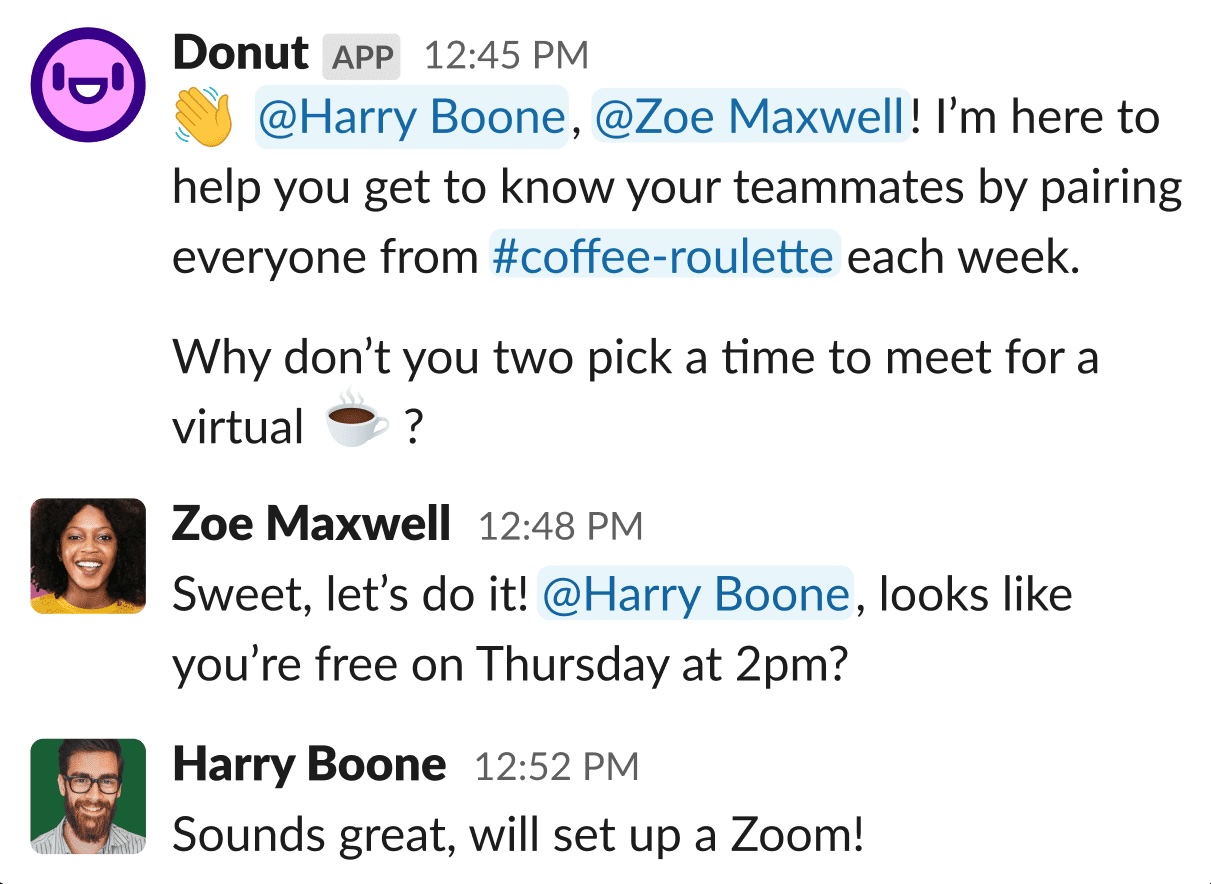
Por supuesto, no hay nada como pasar tiempo en persona con los compañeros. En el caso de las empresas con una plantilla híbrida, se pueden gestionar las solicitudes de mesas en la oficina y los horarios directamente desde Slack. Utiliza la integración con la aplicación Scoop para preguntar cuándo van a estar todos en la oficina, ver un resumen personalizado de los planes de oficina de tus compañeros y fijar la hora que mejor les venga a todos para reunirse. La aplicación Robin es perfecta para gestionar las solicitudes de mesas, mientras que Semana ayuda a mantener sincronizados los horarios de trabajo de todo el mundo.
Consulta la lista completa de aplicaciones de gestión de oficinas.
Canales de reconocimiento
Cuando no ves a tus compañeros cara a cara todos los días, puede ser difícil saber si se valora tu trabajo. Crea una cultura positiva de reconocimiento con canales de agradecimiento, como #enhorabuena o #chin-chin. Establece un recordatorio cada viernes para animar a los empleados a enviar un mensaje de reconocimiento a una o varias personas que hayan ayudado a llevar a buen puerto un proyecto o a cerrar una gran negociación.
Si quieres mejorar la forma en la que se reconoce el buen trabajo en tu empresa, echa un vistazo a estas integraciones de aplicaciones:
- HeyTaco: todo el mundo dispone de cinco tacos virtuales para repartir cada día entre sus compañeros (a través de un mensaje) y mostrar su gratitud o celebrar logros destacados.
- PeerFives: un flujo de trabajo sencillo con un sistema basado en puntos permite a los empleados reconocer el trabajo duro de los demás. Una vez que un empleado alcanza cierta cantidad de puntos, puede canjearlos por divertidos premios en la tienda de PeerFives.
- Dankon: los empleados pueden enviar a sus compañeros una bonita tarjeta de agradecimiento directamente desde Slack. Personaliza el color de las tarjetas y añádeles divertidos emojis para alegrarle el día a alguien.
Encuestas periódicas sobre el compromiso de los empleados
Entre la contratación, la incorporación, las solicitudes de vacaciones y otras muchas tareas, puede ser difícil mantener el compromiso de los empleados. ¡Slack al rescate! La plataforma facilita el seguimiento del nivel de compromiso desde el mismo lugar de trabajo.
Utiliza Polly para crear encuestas de una o varias preguntas para tus empleados, como:
- Reuniones de sincronización diarias
- Preguntas y respuestas durante las reuniones de toda la empresa
- Revisiones trimestrales
- Controles de compromiso semanales o mensuales
Podrás obtener resultados más rápidamente, ver las respuestas en tiempo real y acceder a los datos en paneles fáciles de entender.
Personalización de emojis
Los emojis son una forma estupenda de sacar adelante el trabajo sin dejar de divertirse. Cada espacio de trabajo de Slack incluye un paquete preinstalado, pero las empresas pueden crear fácilmente los suyos propios para darle más vidilla a los mensajes.
Anima a los empleados a añadir emojis a la biblioteca de tu empresa. También puedes formalizar el proceso de creación de emojis limitando los permisos del creador de emojis y creando un formulario de solicitud mediante el creador de flujos de trabajo.
En primer lugar, gestiona los permisos de los creadores de emojis y, a continuación, crea tu formulario de solicitud de emojis. Incluye campos relevantes en el formulario, como la imagen que se utilizará (incluye los requisitos de formato) y la convención de nomenclatura (por ejemplo, #el-trabajo-en-equipo-es-la-clave-para-alcanzar-grandes-logros). No te olvides de fijar el enlace del formulario en la parte superior del canal correspondiente. Te recomendamos hacerlo en canales abiertos a los que tengan acceso todos los empleados, como #para-toda-la-empresa o #cultura-de-empresa. Una vez enviado el formulario, un administrador puede aprobar la solicitud y crear el nuevo emoji o denegarla si no cumple los requisitos específicos o infringe las políticas de la empresa.
Descubre más formas de utilizar los emojis para agilizar el trabajo.
¿Quieres más información?
Slack te ayuda a ti y a tus equipos a seleccionar a nuevos empleados con mayor rapidez, favorece la coordinación e impulsa el compromiso para que la empresa prospere. Para obtener más información sobre cómo sacar el máximo partido a Slack, consulta nuestro Centro de Ayuda.







